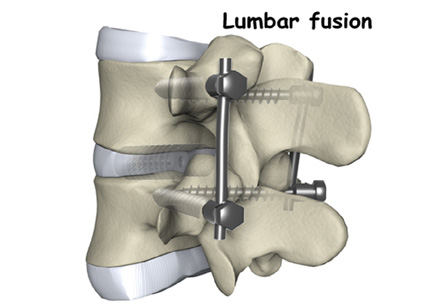Lumbar Spinal Fusion
Introduction
A spinal fusion surgery is performed to stop the motion at a painful vertebral segment, which in turn decreases pain generated from the joint.
There are many approaches to lumbar spinal fusion surgery. They usually involve adding bone graft to an area of the spine to set up a biological response that causes the bone graft to grow between the two vertebral elements and create a fusion.
For patients with the following conditions, a fusion may be considered:
1. Degenerative disc disease
2. Spondylolisthesis
3. A weak or unstable spine (caused by infections or tumors)
Iran ranks among the top 10 countries in orthopedics and Iranian surgeons perform high quality orthopedic surgeries at highly affordable prices

4. Spinal fractures
5. Scoliosis or deformity.
The spine is not actually fused at the time of the surgery. Instead, the surgery creates suitable conditions for the spine to fuse. The fusion process sets up over a 3 to 6 month (and up to 18 month) period of time following the spinal fusion surgery.
Lumbar spinal fusion surgery is usually considered when:
1. There is no pain relief from non-surgical treatment (such as physical therapy, medications, and other treatments)
2. Low back pain that limits their ability to function in their daily activities at work or at home
3. A specific disc space is identified as the pain generator and other possible causes of the low back pain have been ruled out.
Most low back pain can be effectively managed with a variety of conservative treatments such as physical therapy, weight loss, smoking cessation, chiropractic treatment, steroid injections, and traction etc.
Purpose of a fusion:
The pain originates in levels of the spine where the bones are slipped or the discs or joints are damaged. This may be due to irritated nerve endings around the disc, bone, or joints, or it may be due to actual entrapment of the spinal nerves in that region. The pain can be improved by eliminating motion across the damaged level. The fusion eliminates motion at that level of the disc space.
A one-level fusion fuses together two vertebral bones on either side of a diseased disc. A two-level fusion links or fuses together three vertebral bones with two intervening discs. A fusion is an actual bridge of solid bone that is created by surgery.
Procedure:
A lumbar fusion can be achieved in a variety of ways and through several different approaches to the spine. This can be done by taking an incision on the abdominal wall, flank, backside, or a combination of these approaches. The surgeon will decide which approach is required for a particular patient by ordering x-ray studies. The surgeon will select the approach and technique that is best suitable for the spine.
The surgeon also decides whether titanium metal screws would be beneficial. These are typically placed through the pedicle of the vertebra and help in securing the back, middle, and front parts of the vertebral bones. These screws are attached to a rod or plate that is contoured to the spine. This type of spinal “instrumentation” provides immediate strength to the spine during the bone fusion.
The surgeon also decides whether titanium metal screws would be beneficial.
A titanium metal cage or bone cylinder may be screwed into the disc space. This is called an interbody fusion as it is between the “bodies” of the vertebral bones. This can be done from the front or from the backside. The abdominal approach may be done by laparoscopy with several small incisions or open through a single incision.
After this, the metal cages or cylinders are packed with bone graft taken from either the pelvis (ileum) or tailbone (spinous processes and laminar bone). Bone graft is the source of bone cells to help initiate the fusion process at the surgery site. Cages may also be used in conjunction with pedicle screws.
Other techniques involve placement of bone marrow along the sides of the spine. This is called as posterolateral lumbar fusion. The source of the bone graft material in the pelvis (ileum) can remain painful for weeks or months following surgery but gets better in the majority of patients.
Risks and Recovery
The risks involved are similar to any spine surgery and this should be discussed beforehand with the surgeon.
Following surgery, the patient is asked to wear a plastic brace or cloth corset for some weeks to months.
The process of healing a fusion can take many months or well over a year to be complete. Therefore, patience following the surgery will be necessary. The bone fusion is a long process of improving the back and leg pain. Total or 100% cures are rare. However, patients can expect a dramatic and lasting improvement in the back and leg pain. The majority of patients eventually regain the ability to bend in all directions. The mobility can allow for a return to work and enjoyable recreational activities.